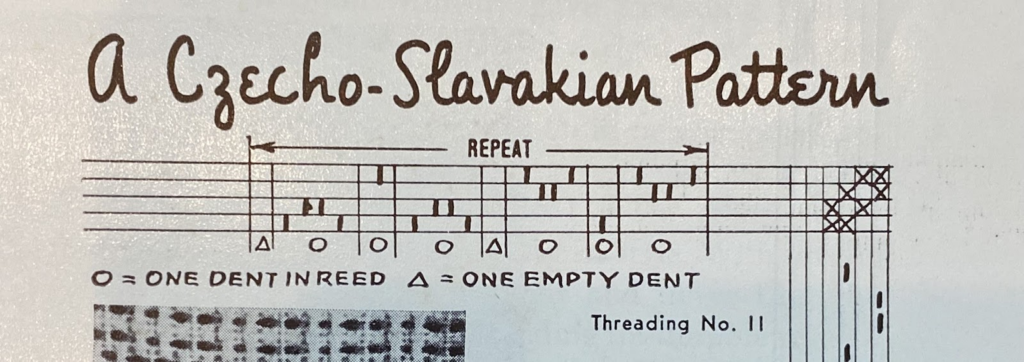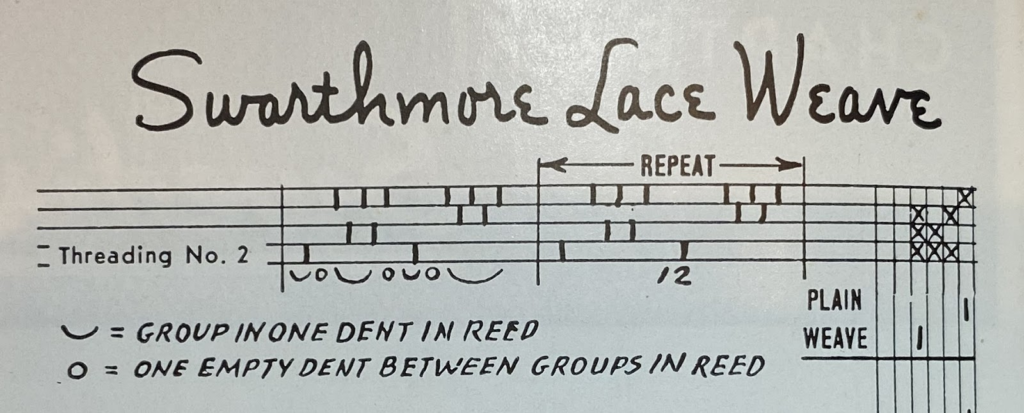When you’re sleying every dent in the reed with the same number of ends, it’s pretty easy to tell how many ends per inch you’ll get: you just multiply the number of ends per dent by the number of dents per inch and presto, there’s your answer.
For example:
1 end per dent x 12 dents per inch = 12 ends per inch
2 ends per dent x 12 dents per inch = 24 ends per inch
But what if you’re not sleying the same number of ends in each dent? What if your sleying pattern is 1|2|1|2, or something even weirder, like 0|1|0|5?
It’s less obvious how to figure things out in this situation.
If all you need right now is the answer to your current sleying storying problem, here’s a calculator that will give it to you:
Calculate EPI or DPI based on sleying repeat
To use the calculator, enter the sleying pattern in the first field, making sure to put a separator like a dash, space, or comma between each number in the pattern. Then enter either the DPI of the reed you’ll be using in the second field or the EPI you’re aiming for in the third. When you do that, the other number will be calculated automatically. (So will ends per sleying repeat and dents per sleying repeat. You don’t need those for the calculator, but they’re useful if you want to know how to do the math on your own.)
If you’d like to understand how the calculator works or need help figuring out what the sleying pattern is, read on!
What sett will you get?
Here’s the math you need to calculate EPI based on your choice of reed yourself, without the calculator:
ends ÷ dents x DPI = EPI
- Ends = the number of ends in the sleying repeat
- Dents = the number of dents in the sleying repeat
- DPI = the number of dents per inch (or cm) in your chosen reed
- EPI = the number of ends per inch (or cm) you’ll get with the given sleying pattern in your chosen reed.
The last two things are pretty straightforward, but for the first two you need to know what the sleying repeat is. Note that even though the labels say “inch” the equation works for metric reeds too.
Sleying repeat
The sleying repeat is the repeating pattern in which we sley the dents of the reed.
Normally choosing a sleying pattern has nothing to do with the threading and everything to do with sett. We know what sett we want and choose a sleying pattern to accomplish that.
When a project recipe or sett chart tells you how to sley a reed, what it’s giving you is the sleying repeat. It might look like 1-2-1-2 or 1|2|1|2, for example.
Sometimes, though, we decide on a sleying pattern first and then want to know how many ends per inch or cm that turns into based on our choice of reed. Maybe we’re weaving crammed and spaced stripes, or maybe we’re using a threading that suggests a particular sleying pattern.
Here’s an example from Marguerite Davison’s A Handweaver’s Pattern Book, for instance:

In this example, the vertical lines divide the threads into groups. Some of those groups have four ends, some have just one, and some of the groups are empty. Each group represents a single dent in the reed.
It’s customary to read a threading from the tie-up out, so for this example I’ll read both the threading and the sleying notations from right to left.
The first group, at the right end of the threading, has 4 ends. The second group has just 1 end. The third group has 4 ends again. Then there’s an empty dent. This part of the pattern goes 4-1-4-0. In the second half of the threading, the warp ends are on different shafts but the sleying pattern stays the same: 4-1-4-0. That means the sleying repeat is really just 4-1-4-0 over and over.
To determine the number of dents in the sleying repeat, count the individual numbers, including the 0s. This example has four numbers and therefore four dents per sleying repeat.
To determine the number of ends in the sleying repeat, add up all the numbers. This example has 4+1+4 = 9 total ends per sleying repeat.
Now all we need is to decide what reed we’ll be using and then plug the numbers into the equation
ends ÷ dents x DPI = EPI
For example, if we were going to use a 12 dent reed, the equation would be
9 ÷ 4 x 12 = 27 EPI
If we used an 8 dent reed, we’d get
9 ÷ 4 x 8 = 18 EPI
What reed should you use?
Note: If a threading includes an unusual sleying pattern, that’s often precisely because it weaves up better at something other than a normal, evenly spaced sett. Aiming for a specific sett is not necessarily your best bet.
That’s good news, since reversing the equation to figure out the dents per inch or cm of the reed to use for an irregular sleying pattern is rarely going to give you nice, round numbers.
Now on to the math!
If you want to know what reed to choose in order to get a particular sett when your sleying pattern is irregular, you need a slightly different equation:
dents ÷ ends x EPI = DPI
Ends and dents are the same as before, they’ve just swapped places. So have EPI and DPI.
Suppose we wanted to use the sleying pattern from the example and achieve a sett of about 16 EPI.
4 ÷ 9 x 16 = 7.111 DPI
Chances are slim that you’ve got a 7.1 dent reed kicking around, but an 8 dent reed will give you something not too far off 16 EPI.
We calculated above that an 8 dent reed will actually give you 18 EPI, but because the threads are crammed and spaced, the fabric won’t feel the same as if you’d gotten 18 EPI with a regular sleying pattern like 3/dent in a 6 DPI reed, or 1-2-1-2 in a 12.
Example #2
Here’s another example, also from A Handweaver’s Pattern Book:

This draft shows two threading repeats. The one on the right is in Davison’s usual threading notation. The one on the left is spaced out considerably to make room for the sleying notation, but the threading isn’t any different.
This time there aren’t any vertical lines to show the groups (dents) but the idea is the same. Just like before…
- Dents = the number of groups in the sleying repeat (that is, the number of symbols)
- Ends = the total number of warp ends in the same section
If you’re comfortable reading those numbers right from the diagram, great! If not, you might find it helpful to write them out the way we did before. I’m going to write them out, partly because this draft has an error in the sleying notation that isn’t obvious until you analyze it a bit.
This time the tie-up is at the left, so I’ll read the sleying pattern from the left end.
This draft’s sleying instructions say to put one thread in the first dent (o) then to leave a dent empty (x), then one thread in a dent (o), then leave a dent empty. So far, that’s 1-0-1-0. Then there are three ends in a single dent followed by an empty dent. So the first half of the threading repeat is sleyed 1-0-1-0-3-0.
Notice that there’s an empty dent after every dent with threads in it. That is, every other number is a 0.
The second half of the threading repeat has the same number of ends, so it’s logical to expect the second half of the sleying repeat to use the same number of dents and to follow the established pattern of an empty dent after each one that isn’t empty.
That isn’t how it’s written, though: there’s no empty dent indicated after the last group of three ends sleyed through a single dent. As it’s written, the full sleying repeat is…
1-0-1-0-3-0-1-0-1-0-3
…and if we repeated that denting exactly as written for multiple threading repeats, we’d get this:
1-0-1-0-3-0-1-0-1-0-3-1-0-1-0-3-0-1-0-1-0-3-1-0-1-0-3-0-1-0-1-0-3
The every-other-dent-is-empty pattern is interrupted at the end of each threading repeat.
So which version is right? Normally we wouldn’t know for sure whether there was an error in the notation or whether Davison really intended this interruption in the pattern. In this case, we can tell because she also tells us that the sleying pattern should give us 25 ends to 2 inches (or 12.5 EPI) in a 15 DPI reed.
If you put the sleying repeat exactly as written into the calculator above, you’ll see that a pattern of 1-0-1-0-3-0-1-0-1-0-3 in a 15 DPI reed actually results in a sett of 13.64 EPI, or about 27 ends in two inches, not 25. If you add the missing 0 at the end of the sleying repeat, though, you get exactly the 25 ends per two inches that she expected.
The good news is that, with such an irregular denting, the difference between 25 and 27 ends per two inches probably won’t be very significant, so you can use either version.
Example #3
Here’s another example of a sleying repeat from A Handweaver’s Pattern Book, and once again there’s a missing o at the end:

Can you figure out how many dents and ends per sleying repeat this draft recommends?
As it’s written, the sleying repeat for this pattern is 3-0-1-0-3-0-1, which is a total of 12 ends in seven dents.
Once again, the intent is almost certainly that there be an empty dent after each non-empty dent. That means that the full repeat should actually be 3-0-1-0-3-0-1-0, which can be reduced to just 3-0-1-0. (You don’t have to reduce the pattern. 6 ends in 4 dents is just the same ratio as 12 ends in 8 dents.)
If I were going to sley this threading, I’d use the second version, with an empty dent after each one that isn’t empty, which has a total of 6 ends in 4 dents (or 12 ends in 8 dents if it’s not reduced).
Once you figure out what the sleying pattern is, you can use the equations above or jump back to the calculator to determine EPI based on chosen reed, or DPI required to get a particular sett.

Academy Members can learn more from these lessons:

Sett and Yarn Size

Typical Setts for Common Weaving Yarns

Twill Ratios and Sett
